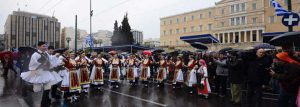![]() By Margarita Poulakou
By Margarita Poulakou
The 25th of March is a defining day for Greece. It is the date that celebrates the start of the uprising against the Ottoman Empire, which led to Greece’s independence. Thus it is a day of national pride. The most visible and expressive form of celebration is the parade. All over Greece parades are staged by communities large and small, usually involving local primary and high school students marching behind the Greek flag. But the peak of festivities is reached at the center of Athens with an impressive, one could say grandiose, military parade. This year’s parade was atypical, with a strong flavour of tradition at the end. The celebration was concluded with national dances from different regions of Greece.
Many questions were raised, whether it is appropriate for a leftwing government to endorse such traditional forms of celebration, sometimes associated, wrongly, with autocratic periods of modern Greek history. Few have focused on the real role that dance can play in the context of historical celebrations, especially those linked with the very identity of people.
Traditional dances are a form of a nation’s cultural expression. The costumes, the music, the steps, all seem to be elements of the authentic values that typify a nation. The dancing bodies represent and give life to the principles and the character of the culture. In this case the chosen dances were local dances from different regions of Greece. And no, it was not the renowned sirtaki of Zorba the Greek, but dances like “tsamikos” and “pentozalis”. “Tsamikos” is maybe one of the most well known dances in Greece, performed only by men to symbolize the values of bravery and manliness. While all dancers follow a particular sequence of steps, the first dancer performs steps of admirable difficulty and accuracy. “Pentozalis” is a dance from the island of Crete, very quick, rhythmic and complex, often danced by men only as well.
Was the choice of “staging” traditional dances in the streets of Athens a purposeful one, to give a joyful conclusion to the parade? Undoubtedly, this kind of embodied conclusion is a way of making the “spectators” participate actively in the celebration; not only observe a parade from a distance, but also engage in it and feel through this action pride and joy. These are feeling that Greeks do not experience often these days of financial crisis and austerity. But it is also important to understand that the representation of folk dances can be and can be used as an essentialist portrait of the respective nation-state.
To what end, someone could ask. In the past dance has been used as a way to create and promote a common national identity. Anthony Shay in his book Choreographing politics studies national folk ensembles and demonstrates how this strategy was implemented. A characteristic example is the Moiseyev Dance Company in the former Soviet Union. Although this phenomenon hasn’t appeared in Greece, dance has always been a piece of the nation’s history, an active cultural expression, present until today in all sorts of celebrations.
We have to combine this example of cultural expression with its sociopolitical context to gain a more clear understanding of the strategy behind it. It is far from just a populist approach on the occasion of a national holiday. In this critical juncture, during which Greece struggles politically and financially, and prospects are becoming gloomier every day, the government chooses to play the “patriotic card” to make the people feel secure, proud and respected. It is a way to control the sentiment of national identity, to reinforce it against the prospect of a Grexit. Building an enduring national front is a conscious choice, and historically has proved to be effective in mitigating national failures. The representation of these dances alongside with the tanks and the army should not make us wonder. The purpose is clear: projecting the past into the present helps define the future. The analogies are also evident. The brave Greeks once revolted against a tyrannical empire for the ideal of freedom. Today’s Greeks are purported to resist against those forces that limit democracy and impose economic demise. In such a way stereotypes are instilled into the popular imagination, to allow masses to identify themselves with the ideal of national heroism.
The traditional dances, when performed outside the context that created them, become an imitation of the proper dance, a recreation. They become a tool of representation of nations and their cultures. All the more, when represented in the context of a military parade. The symbolism of this year’s 25th March celebration in Athens is powerful and crucial. It shows how unadulterated patriotism can be manipulated to serve nationalistic ideas and a political agenda. It could be meant to demonstrate a strengthening of Greek resolve to get out of the crisis in heroic national solidarity; but could also mean a progressive distancing of Greece from the rest of Europe with a retreat into a glorified past.
Margarita Poulakou is a practitioner and theorist of dance. After becoming a professional dancer, she performed and extensively taught classical and character dance. She holds a Master’s degree in Theory and Practice of Arts. She is currently a PhD candidate at the University of Nice – Sophia Antipolis, where she examines the process of identity building through dance and the social and political interactions with art in the Parisian society of the 19th century.


